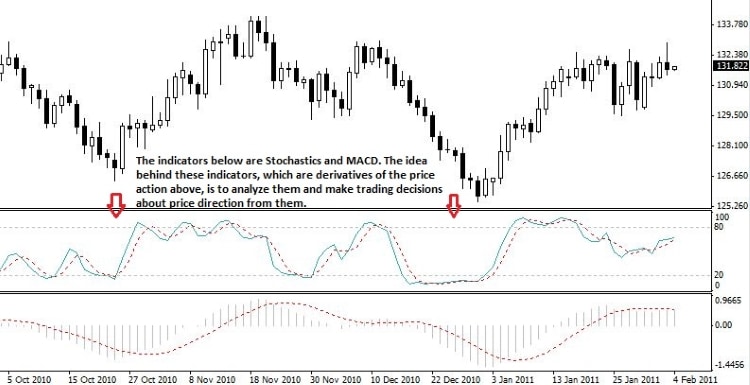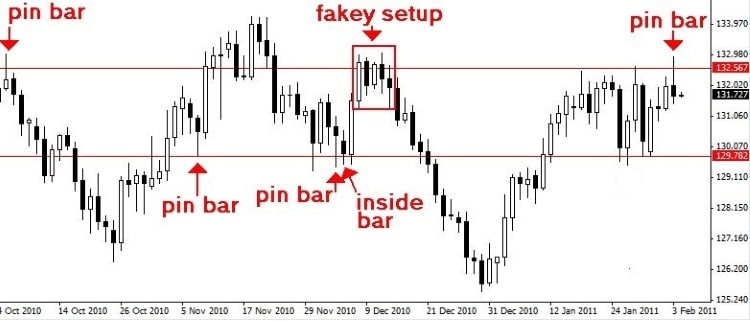 In this article, we will delve into the reasons why relying on indicators can hinder your success as a trader and why it is more beneficial to master the art of trading using uncomplicated price action setups. Say goodbye to the chaotic clutter that indicators create on your charts, and allow this article to enlighten you about the effectiveness and simplicity of trading with pure price action.
In this article, we will delve into the reasons why relying on indicators can hinder your success as a trader and why it is more beneficial to master the art of trading using uncomplicated price action setups. Say goodbye to the chaotic clutter that indicators create on your charts, and allow this article to enlighten you about the effectiveness and simplicity of trading with pure price action.
1. The Limitations of Indicators: First-Hand vs. Second-Hand Data
The primary issue with relying on indicators for Forex market analysis stems from the fact that all indicators are derived from second-hand information. Instead of directly examining the actual price data, traders attempt to interpret and analyze various derivatives of price data. Essentially, when traders base their decisions on indicators, they obtain a distorted perspective of the market’s behavior. By removing these distortions, represented by indicators, one can gain a clear and unobstructed view of the price movements within any given market. While it may sound straightforward, many novice traders fall into the trap of enticing marketing campaigns promoting indicator-based trading systems or mistakenly believe that mastering complex and visually appealing indicators will guarantee consistent profits. Unfortunately, this misconception couldn’t be further from the truth. Let’s begin by exploring the two main categories of indicators and uncover their flaws:
Lagging and Leading Indicators
Technical chart indicators can be classified into two categories: lagging indicators and leading indicators. Lagging indicators, also known as momentum indicators, include popular ones like MACD and moving averages. They claim to assist traders in identifying trending markets. However, a significant drawback is their delayed nature. Lagging indicators tend to generate buy or sell signals after a market has already started trending, usually when it is on the verge of a counter-trend retracement. Moreover, lagging indicators such as MACD and moving averages can lead to numerous false signals in consolidating markets, triggering buy or sell signals just as the market is about to reverse and re-test the opposite side of the trading range or consolidation area. Therefore, the primary usefulness of lagging indicators lies in identifying trending markets.
Oscillators: A Pitfall in Trending Markets
Leading indicators often referred to as oscillators, include popular ones like the stochastic, Parabolic SAR, and Relative Strength Index (RSI). These indicators oscillate or move between buy and sell signals. However, they perform poorly in trending markets because they constantly indicate “overbought” and “oversold” conditions throughout most of the trend. In a strong uptrend, for instance, an oscillator will consistently show the market as overbought, even if the market continues to rise for an extended period. Conversely, in a downtrend, oscillators will frequently indicate oversold conditions. This implies that leading indicators attempt to prompt traders to identify market tops and bottoms, suggesting that the market is due for a correction. However, this may not necessarily be the case, as the duration of a trend is uncertain. As a result, numerous false signals occur before the actual top or bottom of the market is reached. Interestingly, examples provided by individuals promoting indicator-based trading systems often showcase the exact top or bottom while conveniently omitting the numerous losing signals that preceded it.
Due to the limitations of lagging indicators in consolidating markets and the shortcomings of leading indicators in trending markets, traders often attempt to combine them on their charts to “filter” each other’s signals. Unfortunately, this blending of opposing indicators results in confusion, clutter, self-doubt, excessive trading, overleveraging, and a myriad of other emotional trading mistakes.
2. Simplified Charts vs. Complex Charts: Embracing Pure Price Action
Let’s examine how many traders clutter their charts with lagging and leading indicators and compare it to the alternative approach of trading solely based on plain, unadorned price charts and price action.
Below is a daily chart of EURUSD adorned with popular indicators such as stochastic, MACD, Parabolic SAR, and a few moving averages. A quick glance at this chart reveals its confusing nature and the unnecessary variables it contains. Making trading more challenging than necessary is simply counterproductive, and the presence of multiple indicators on the chart exemplifies this:
 Now, let’s shift our attention to the same chart without any indicators. Here, we solely observe pure price action with the addition of a few horizontal lines to indicate significant support and resistance levels. It becomes evident that this chart is less cluttered and less confusing, showcasing the natural movement of the EURUSD price. By acquiring the skill to interpret this natural price behavior and the accompanying conditions, we can engage in a straightforward yet highly effective trading approach.
Now, let’s shift our attention to the same chart without any indicators. Here, we solely observe pure price action with the addition of a few horizontal lines to indicate significant support and resistance levels. It becomes evident that this chart is less cluttered and less confusing, showcasing the natural movement of the EURUSD price. By acquiring the skill to interpret this natural price behavior and the accompanying conditions, we can engage in a straightforward yet highly effective trading approach.
Additionally, it is worth noting that the absence of indicators beneath the price, such as the MACD and stochastic indicators in the previous chart, grants an unobstructed view of the price itself. This unrestricted perspective provides a clearer and broader understanding of price action compared to charts burdened with multiple indicators occupying the lower portion of the screen, as seen in the preceding example.
3. Clarity: Embracing Indicator-Free Charts
The contrast between the two images above clearly highlights the significant and undeniable clarity that arises from trading with indicator-free, pure price action charts. Maintaining focus is crucial for traders, and having five different indicators on your charts, each conveying conflicting messages, only serves to distract and confuse rather than promote a clear and focused mindset.
By reducing the number of parameters to analyze your brain functions more efficiently, allowing you to rely on your innate trading instincts. These instincts become finely honed and fully developed as you learn to interpret price action on a “naked” price chart. As you progress as a proficient price action trader, you will gradually cultivate the ability to make trading decisions with increasing accuracy and less effort.
4. Examining Popular Indicators: Stochastic and MACD
Let’s delve into the mechanics of two widely used indicators: Stochastic and MACD, and then compare them to the simplicity and effectiveness of trading based on pure price action.
The Stochastic indicator:
The Stochastic oscillator comprises two components: the %K and the %D. The %K represents the main line, indicating the number of time periods, while the %D is the moving average of the %K.
Understanding the formation of the Stochastic is one thing, but comprehending its behavior in different scenarios is more crucial. For example:
• When the %K line drops below 20, it signals an oversold condition and a potential buying opportunity.
• If the %K peaks slightly below 100 and starts to decline, it is advisable to sell before it drops below 80.
• Generally, if the %K value rises above the %D, and both values are below 80, it indicates a buy signal. However, if they are above 80, the security is considered overbought. (The above information about the Stochastic oscillator is quoted from investopedia.com)
The MACD indicator:
The MACD is an oscillating indicator that fluctuates above and below zero. It is calculated by subtracting the 26-day exponential moving average (EMA) from the 12-day moving average of a security’s price. The resulting value creates an oscillating indicator. When a trigger line, represented by the nine-day EMA, is added, it facilitates comparison and generates a trading picture. A bullish moving average crossover occurs when the MACD value is higher than the nine-day EMA.
Notably, the MACD can be used in several ways:
• Identifying divergences or crossovers of the histogram’s center line. Buy opportunities are indicated above zero, while sell opportunities are suggested below.
• Paying attention to moving average line crossovers and their relationship to the center line. (The above information about the MACD is quoted from investopedia.com.)
Upon examining the descriptions of the Stochastic and MACD indicators, the multitude of parameters and rules involved in their calculation and application becomes mentally burdensome. The overarching theme of such indicators is that specific rules must be followed to utilize them effectively. Consequently, traders find themselves glued to their computer screens, awaiting the precise alignment of multiple indicators before entering a trade. Combining two or more indicators and seeking confirmation from each before taking action further compounds the confusion. The resulting amalgamation of tangled and overly complex lines, colors, and signals on charts can easily induce panic and frustration.
Now, let’s compare charts featuring the Stochastic and MACD indicators with charts based solely on pure price action, marked by essential trading signals.
Take a look at the following chart, which includes the Stochastic and MACD indicators:
 Now, observe the same chart below, stripped of indicators, and displaying only price action setups and support/resistance levels:
Now, observe the same chart below, stripped of indicators, and displaying only price action setups and support/resistance levels:
When performing such a comparison exercise, the advantages and logical nature of trading based on pure price action become apparent. Why analyze convoluted lines derived from “core” price data when you can learn to interpret and trade successfully using simple price action setups, which are the actual “core” data? In sales terms, trading with price action eliminates the middleman and allows direct interaction with the producer.
 The chart below represents the daily movement of gold. Take note of how the Stochastic indicator consistently signaled an overbought condition for multiple months in 2010, coinciding with a robust and vigorous uptrend that offered numerous profitable price action opportunities. If you had relied solely on the Stochastic indicator, you would have been constantly anticipating the market’s top, as the indicator indicated an “overbought” status every day. This serves as evidence that the most crucial aspect in any financial market is the information conveyed by price action, rather than relying on mathematical equations that predict what “should” happen. It is widely known that what is expected to occur in a market often diverges from what actually happens unless it is revealed by price action signals.
The chart below represents the daily movement of gold. Take note of how the Stochastic indicator consistently signaled an overbought condition for multiple months in 2010, coinciding with a robust and vigorous uptrend that offered numerous profitable price action opportunities. If you had relied solely on the Stochastic indicator, you would have been constantly anticipating the market’s top, as the indicator indicated an “overbought” status every day. This serves as evidence that the most crucial aspect in any financial market is the information conveyed by price action, rather than relying on mathematical equations that predict what “should” happen. It is widely known that what is expected to occur in a market often diverges from what actually happens unless it is revealed by price action signals.
 Now, let’s examine the same chart with only price action displayed:
Now, let’s examine the same chart with only price action displayed:
 Each arrow in the above chart indicates a price action setup. If you had traded this uptrend in gold last year, it would have been evident that trading based on price action alone would have been far more advantageous than attempting to over-analyze and complicate matters with a multitude of messy indicators cluttering your charts.
Each arrow in the above chart indicates a price action setup. If you had traded this uptrend in gold last year, it would have been evident that trading based on price action alone would have been far more advantageous than attempting to over-analyze and complicate matters with a multitude of messy indicators cluttering your charts.
5. In conclusion…
If it hasn’t become abundantly clear by now, price action trading stands out as a vastly superior Forex strategy compared to any indicator-based approach. To truly grasp price dynamics and the inner workings of financial markets, it is essential to master the analysis of price action on a chart free from indicators. Even if you don’t aspire to become an expert in price action trading, it is still crucial to possess a solid understanding of how to analyze a “naked” price chart and effectively trade with only price action and key market levels. Incorporating this knowledge into any other trading strategy or system will enhance its effectiveness.
Indicators, in essence, breed complacency by fostering the belief that you don’t need to put in any effort or learn beyond deciphering your “mechanical” indicators that supposedly dictate your actions. Price action, on the other hand, empowers you to make decisions about future market outcomes and directions with greater accuracy and speed than any other trading method, as it represents the most up-to-date tool for market analysis. Over time, your mind and subconscious will harmonize, and trading based on pure price action setups will become second nature, much like riding a bike. Price action is the cleanest and most logical approach to analyze and trade the Forex market. Embrace price action trading sooner rather than later to steer your trading journey in the right direction.


